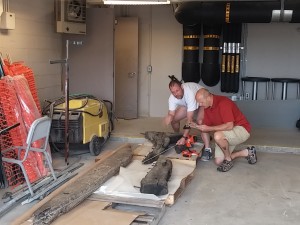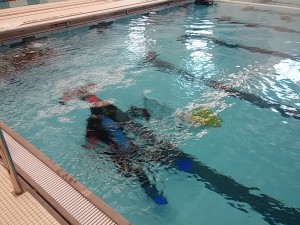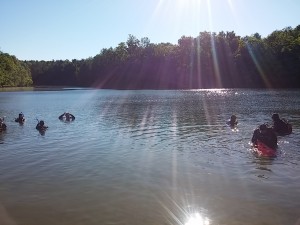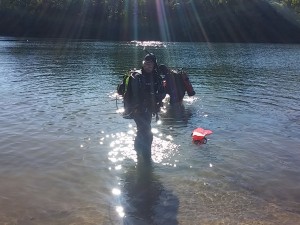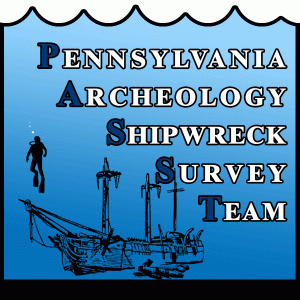By Lara Homsey-Messer
From May 16 to June 17th, 10 students from IUP and 2 students from Clarion University ventured to the Squirrel Hill site in New Florence, PA, to learn archaeological field techniques, including excavation methods, shovel testing, and using high-tech equipment such as a total station and ground penetrating radar.
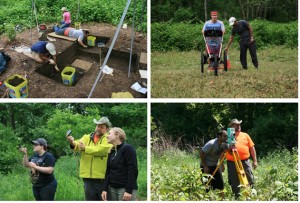 Clockwise from upper left, students practicing test unit excavation,
Clockwise from upper left, students practicing test unit excavation,
ground penetrating radar survey, using a compass, and using a total station.
Perhaps the most humorous aspect of this site is the feeling that you are on the set of LOST and that something might come crashing out of the bamboo jungle at any minute…well, technically it is Japanese Knotwood, but it sure looks like bamboo and is clearly where the phrase “grows like weeds” comes from. These hardy students braved not only the bamboo (as we lovingly called it), but also a six-day work week (yep, Monday through Saturday folks), a gypsy moth caterpillar infestation (it’s hard to keep a unit floor clean with these buggers falling in every other second), more than one drenching storm (being dry and clean is totally overrated…), and all sorts of critters running amuck in our test units (we miss our resident mouse in Test Unit 2).
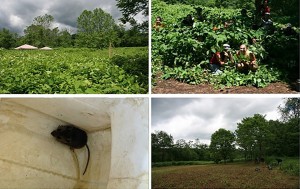 Representative pics of the “bamboo” (top), an impending mid-afternoon storm,
Representative pics of the “bamboo” (top), an impending mid-afternoon storm,
and our cute resident mouse.
Seriously, though, these students learned a lot about not just archaeology over these five weeks, but also the Monongahela folks who lived in this village over five centuries ago. Squirrel Hill has been known to archaeologists since the 1950s, and has been heavily collected by local residents for decades. The site is currently listed on the National Register of Historic Places and the land it sits on is now owned by the Archaeological Conservancy. The site is believed to be a Johnston-phase Monongahela village (ca. 1450-1590). Very little systematic study has been conducted at the site, so many questions remain to be answered, including its occupation and cultural affiliations; location & extent of site boundaries; the internal arrangement of houses, plaza, and stockades; and its relationship with neighboring communities such as the Johnston Site, the location of previous IUP field schools.
This summer we opened 10, 1 x1 meter, test units in areas that previous geophysical survey identified as “hotspots.” We also conducted additional ground penetrating radar survey and shovel-tested around the Conservancy’s property line. We found pottery, lithic flakes, a LOT of fire-cracked rock, and over 80 features (such as post molds and storage pits). Perhaps most intriguing, we now suspect that there may be more than the one, Johnston-phase, occupation at the site. Many of the post molds intersect and intrude other features, minimally suggesting some rebuilding. Interestingly, we discovered several features (including a large rock cluster), nearly a meter below the surface. Fortunately, we were able to collect charcoal from them for radiocarbon dating; it will be very interesting to see if these enigmatic features are contemporaneous with, or pre-date, the Mon occupation. We hope to have these dates before the end of the calendar year, so check back if you want to find out the results…
 Rock cluster feature nearly a meter below surface (left)
Rock cluster feature nearly a meter below surface (left)
and two possible egg-shaped, post-enclosed storage pits (right).
Many thanks to the folks who visited us this summer and offered their expertise, volunteer labor, support, and enthusiasm. Special thanks to Bill Johnson for sharing his knowledge of Mon ceramics, Sarah Neusius and Bev Chiarulli for expertise on Mon culture, and Dr. and Mrs. Driscoll for their support of IUP Archaeology. Your visits made our day!
 From left to right: Dr. Bill Johnson giving an impromptu lesson on Mon ceramics, Dr. Sarah Neusius giving students excavation tips, and Dr. and Mrs. Driscoll chatting with students.
From left to right: Dr. Bill Johnson giving an impromptu lesson on Mon ceramics, Dr. Sarah Neusius giving students excavation tips, and Dr. and Mrs. Driscoll chatting with students.


